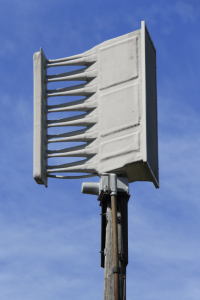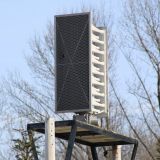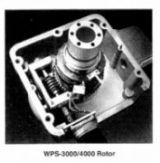WS-3000
| Whelen WS-3000 | |
 A Whelen WS-3000 in Gibraltar, MI. Photo taken by ramguy2500. | |
| Company | Whelen Engineering |
|---|---|
| Produced | 1981-1991 |
| Type | Rotational Electronic |
| Sound output | 124 dB @ 100 ft |
| Wattage | 1280/1600 W |
| Voltage | 24 V DC |
| Preceded by | Whelen WS-2000 |
| Succeeded by | Whelen WPS-4000 |
| Documentation | Manual |
The WS-3000[1] (later known as the WPS-3000) is a rotational electronic siren that was produced by Whelen Engineering for 10 years and was Whelen's first successful rotational siren. This siren established Whelen's dominance in the electronic rotational siren market and paved the way for their future sirens.
History

The WS-3000 was created in 1981 by Whelen Engineering. Whelen had realized by this point that while they were enjoying great success with their omnidirectional WS-2000 series of sirens, they lacked a high-performance siren that could match the rotating mechanical sirens that dominated the siren market at the time. Whelen contacted Bruce Howze from Community Pro Loudspeakers, who had previously designed other sirens such as the WS-2500, to create a rotational electronic siren that could match the performance of Federal Signal's popular Thunderbolt siren. Whelen had already experimented with a rotational siren, the WS-2000R, but its performance was lacking due to its low output and use of collector rings. The WS-3000, which was the first to use Whelen's signature multi-throat projector design and the first to be entirel hardwired, solved the WS-2000R's issues and had unrivaled performance for an electronic siren when it was released. The WS-3000's performance was matched by Federal Signal's EOWS*812 released later the same year.
The design of the WS-3000 was slightly updated in 1987 to include an additional reinforcement bar on the projector and a microswitch-based sensor replacing the optical switch in the rotator. Like Whelen's other sirens, the siren would gain the "WPS" prefix that year, ditching the "WS" prefix. A year later in 1988, the rotator would be replaced entirely by the taller, cube-shaped rotator used on the then-new WPS-4000 siren, standardizing the mechanisms to reduce costs.
The WS-3000 would be discontinued in 1991 shortly after the introduction of the WPS-4000-4, which not only outperformed the WS-3000 but also used fewer, more powerful drivers to do so. This decreased the chance of driver failure, increased the clarity of voice messages, allowed for a shorter and lighter projector, and decreased production costs.
Despite the WS-3000 having been discontinued for over 30 years, many WS and WPS-3000 units still operate in service, most of which are running on Whelen's newer digital controllers or Federal's UltraVoice controllers. A few still run on their original analog controllers, but these are rarer. Unfortunately, some units are beginning to show their age with blown drivers and failing rotator mechanisms. Still, many of these sirens continue to serve many communities and likely will for years to come if maintained properly.
Design

The WS-3000 makes use of 16 80 W (Atlas Sound SD-600 D4F)/100 W (Atlas Sound SD-370) high-powered speaker drivers located inside a removable panel at the rear of the siren. Each driver connects to 16 staggered throats that converge into a single large projector, which is reinforced to prevent the horn from warping. The projector also includes a mesh screen to keep debris out of the siren, in front of 5 (initially 4) reinforcement bars. The siren is rotated using a small aluminum cube-shaped direct-drive reversible rotator (formerly a similar earlier iteration) with a high-torque DC motor, which oscillates 360° at 2 oscillations per minute. This is because the siren does not use brushes, with the drivers directly wired up to the controller instead. Oscillating prevents the wire from snapping, and the direct wired connection improves voice clarity and performance of the drivers. The rotator's design prevents the siren from acting as a weathervane in high winds as well, with the siren being designed to withstand winds of up to 145 mph (233 km/h). The WS/WPS-3000 is able to reach 124 dB at 100 ft.
The rotator is capable of microswitch sensor-based (initially optical sensor-based until 1987) quadrant control, meaning that the projector is capable of being remotely positioned in 8 different directions, with the internal sensor telling the controller which direction the projector is facing. Multiple WS-3000 units can be synchronized from a central control system which prevents the distortion of voice messages from clashing messages from different sirens facing different directions. Every time a WS-3000 unit utilizes its voice functionality, it will automatically return to its "home" position before broadcasting voice messages in each direction, first in the immediate directions, and then the cardinal directions. The pre-ESC-864 and ESC-864 controllers included with the WS/WPS-3000 run the siren's drivers at 100 W in "voice" mode while running at 80 W in "siren" mode.
References
- ↑ The WS-3000 is often mistakenly called the "WS-3016" or "WPS-3016" by various enthusiasts. This name does not exist in Whelen's documentation. The siren's official name is either the WS-3000 or WPS-3000, depending on the controller used and the siren's age.